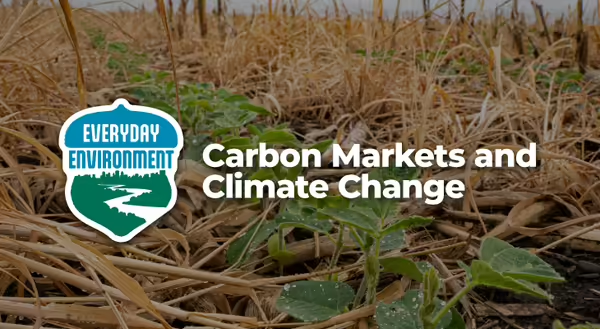
You may have heard of carbon markets, or you may hear anything remotely economic and think: this is over my head. Either way, economic policies that address climate change are necessary to move the dial on reducing emissions, so let’s break down the concept of carbon markets, specifically related to agriculture. Carbon markets are an economic trading system that allows individuals or companies to buy carbon credits as a way to compensate for their greenhouse gas emissions from burning fossil fuels. One carbon credit is equivalent to the reduction, sequestration, or avoidance of releasing one tonne of carbon dioxide, or an equal amount of another greenhouse gas, in the atmosphere. Practices such as wetland remediation, reforestation, and investment in renewable energy all can qualify for carbon credits.
The History of Agriculture Carbon Markets
Carbon markets for agricultural producers became an emerging industry starting in late 2020. Many large agricultural companies launched carbon credit programs designed to pay farmers for applying practices such as reduced or no-till, nitrogen management, and cover crops on their acreage – all of which sequester greenhouse gases. However, paying farmers for climate-friendly practices is not a new idea. Nearly 20 years prior, the Chicago Climate Exchange, a stock exchange for emission sources and offset projects, included a protocol for earning and trading carbon credits in the agriculture sector. The exchange traded from 2003 to 2010 when it ceased due to inactivity. At that time, the effective final price for a carbon credit was between 5 and 10 cents. Since then, the idea of agricultural carbon credits has re-emerged this time in a different political and demand environment compared to the early 2000s.
Farmer Participation in Markets
Currently, farmer participation in agricultural carbon markets is low. One study suggests that 93% of U.S. livestock and crop farmers/managers are aware of carbon markets, but only 3% of those surveyed were currently participating. While participation has been low, industry demand for carbon markets is increasing due to the growing impacts of climate change. A June announcement by Microsoft and carbon credit company Indigo Ag stated that Microsoft has agreed to buy 40,000 agricultural soil-based carbon credits, the most Indigo Ag has ever sold in a single transaction. While many questions still exist about the feasibility and measurement of agricultural carbon credits, this topic is gaining traction and interest as society and industries address the changing climate of our future.
As carbon markets continue to evolve, researchers and economists are looking to see how producers will respond to the opportunity. A recent study looked at how willing Midwest farmers are to accept payment for their climate-friendly practices. It found that at the current prices of $10 and $20 per credit, only 3% and 4% of farmers were willing to change their practices. However, if rates were higher, more like $40 to $70 per credit, more were willing to change their practices, but half still were unwilling to enroll.
Carbon Credit Funding and Policy
Policy can help advance and standardize the agriculture carbon market to ensure it is moving the dial on our carbon emissions. In February 2022, the USDA announced The Partnerships for Climate-Smart Commodities program, providing $3.1 billion in funding for 141 projects to expand markets for climate-smart commodities. This investment is designed to help quantify and verify climate-smart agricultural practices, which will benefit the agricultural carbon market.
Additionally, the U.S. government recently released a new factsheet, Voluntary Carbon Markets Joint Policy Statement and Principles, outlining seven voluntary carbon market principles that show legitimate greenhouse gas sequestration, reduction, and emission avoidance. The principles serve as a suggestion for U.S. market participants to follow and a guideline for how the U.S. government engages with voluntary carbon markets.
Principles 1 and 3 will be of particular importance to agriculture.
- Principle 1 states that carbon credits must meet certain integrity standards and represent real decarbonization. Agricultural carbon credits were initially referred to by many as the “Wild, Wild West” due to the programs' lack of government interference and free market. However, this factsheet clarifies that certain standards must be followed for a working carbon credit program.
- Principle 3 states that corporate buyers of credits need to prioritize measurable emissions reductions within their value chains. This principle implies that companies that use agricultural products and want to make reductions must purchase agricultural carbon credits that reduce carbon along the production process of whatever product they are making. While some concerns have risen about the longevity and potential for agricultural carbon credits compared to other credit generation opportunities, this ensures that there will be at least some demand in the future for agricultural carbon credits by companies who use agricultural products and want to reduce emissions.
Over the last few years, the evolution of agricultural carbon programs, company program offerings, credit prices, and U.S. government policy has been fascinating. As the U.S. navigates a presidential election and the downturn in the agricultural economy due to low commodity prices, there will certainly be many new developments in the agricultural carbon market and policy.
Resources:
- Blog: What you Need to Know about Carbon Markets
- An Overview of Voluntary Carbon Markets for Illinois Farmers
- Making Sense of Carbon Markets Webinar
- Ecosystem Market Information Fact sheet
- Ecosystem Market Webinar Series
This blog was written by Sarah Sellars, an Assistant Professor and Extension Specialist in Sustainable Farm & Food Systems with South Dakota State University.
Thank you for reading!
Everyday Environment is a series of blogs, podcasts, webinars and videos on exploring the intricate web of connections that tie us to the natural world. Check out the podcast episode on this topic to hear more about Agriculture Carbon Markets with Sarah Sellars.
Subscribe to Everyday Environment Newsletter More about Everyday Environment